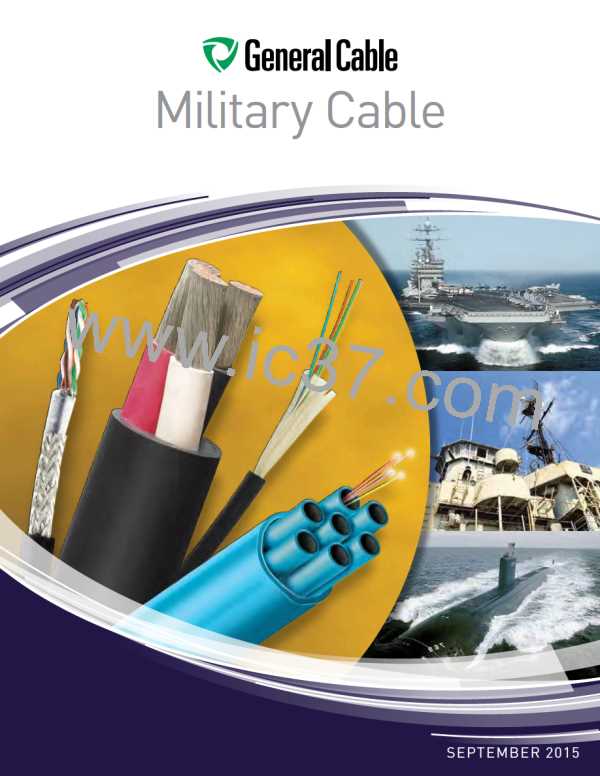Technical Information
Military Shipboard Catalog
Glossary
Served Wire Armor (SWA): Spiral
wrap of galvanized steel wires
applied around a cable to afford
mechanical protection and increase
the cable pulling tension
Skin Effect: The tendency of alternating
current to concentrate and to travel
only on the surface of a conductor.
Tendency increases with increase in
frequency.
TFE: Tetrafluoroethylene. A
thermoplastic material with good
electrical insulating properties
and chemical and heat
resistance.
characteristics, (mineshaft,
submarine cable, etc.). Also used to
denote steel wire armor.
Sleeving: An extruded tube.
Thermoplastic: A material that can
be softened repeatedly by
heating and hardened by cooling
through a temperature range
characteristic of the
Spark Test: A test designed to locate
imperfections (usually pin-holes) in
the insulation of a wire or cable by
application of voltage for a very short
period of time while the wire is being
drawn through the electrode field.
Sheath: The outer covering or jacket of
a multi-conductor cable. Usually
non-metallic.
plastic, and that in the softened
state can be shaped by molding
or extrusion.
Shield (Electrostatic): In cables, a
metallic layer placed around a
conductor or group of conductors to
prevent electrostatic interference
between the enclosed wires and
external fields. Also see Insulation
Shield.
Specific Gravity: The ratio of the density
(mass per unit volume) of a material
to that of water.
Thermoset: A material that has been
vulcanized by heat or other
means and is substantially
infusible and insoluble.
Specific Inductive Capacity (SIC): Same
as dielectric constant (See Dielectric
Constant).
Three Conductor Cable: Three
insulated conductors assembled
with other necessary cable
components (shield, filler, etc.)
to form a core, protected by an
overall jacket.
Shrink Tubing: Tubing which has been
extruded, crosslinked, and
mechanically expanded which when
reheated will return to its original
diameter.
Tank Test: A voltage insulation test in
which the insulated wire or cable is
submerged in water and voltage is
applied between the conductor and
water serving as ground. Shielded
cables are generally not tank tested
due to the possibility of introducing
contaminants on the outer surface of
the insulation.
SIA: Steel Interlocked Armor.
Tinned Copper: Tin coating added
to copper to aid in soldering and
inhibit corrosion.
Side Wall Bearing Pressure (SWBP):
A term used in reference to the
pressure on a cable which is being
pulled around a curved surface
under tension. If excessive, SWBP
can damage cable components and
reduce the life of the cable.
Tray: A cable tray system is a unit or
assembly of units or sections,
and associated fittings, made of
non-combustible materials
Teflon: DuPont Company trademark for
fluorocarbon resins. (See FEP and
TFE.)
forming a rigid structural system
used to support cables. Cable
tray systems (previously termed
continuous rigid cable supports)
include ladders troughs,
Signal Cable: A cable designed to carry
current of usually less than one
ampere per conductor to operate
signal circuit devices.
Temperature Rating: The maximum
temperature at which an insulating
material may be used in continuous
operation without loss of its basic
properties (i.e. operating, overload,
short circuit). The minimum
channels, solid bottom trays, and
similar structures.
Silicone: A material made from silicone
and oxygen.Can be in thermosetting
elastomer or liquid form. The
temperature for safe handling.
Tray Cable: A factory assembled
multi-conductor or multi- pair
control, signal or power cable
specifically approved under the
Canadian Electrical Code for
installation in trays.
thermosetting elastomer form is
noted for high heat resistance.
Tensile Strength: The pull stress required
to break a given specimen Measured
in pounds per square inch. Also
referred to as Ultimate Tensile
Strength.
Phone: (866) 248-7060
Fax: (859) 572-8463
www.generalcable.com

 GENERAL [ GENERAL CABLE TECHNOLOGIES CORPORATION ]
GENERAL [ GENERAL CABLE TECHNOLOGIES CORPORATION ]